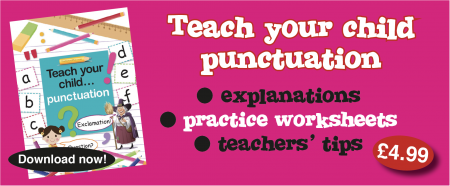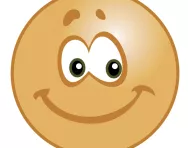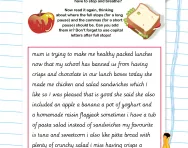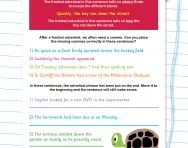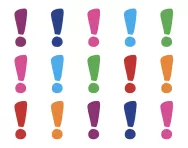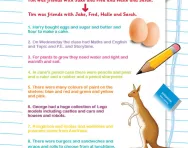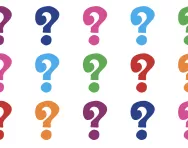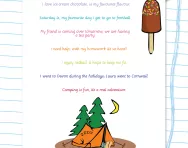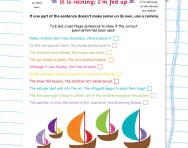TheSchoolRun.com closure date
As we informed you a few months ago, TheSchoolRun has had to make the difficult decision to close due to financial pressures and the company has now ceased trading. We had hoped to keep our content available through a partnership with another educational provider, but this provider has since withdrawn from the agreement.
As a result, we now have to permanently close TheSchoolRun.com. However, to give subscribers time to download any content they’d like to keep, we will keep the website open until 31st July 2025. After this date, the site will be taken down and there will be no further access to any resources. We strongly encourage you to download and save any resources you think you may want to use in the future.
In particular, we suggest downloading:
- Learning packs
- All the worksheets from the 11+ programme, if you are following this with your child
- Complete Learning Journey programmes (the packs below include all 40 worksheets for each programme)
You should already have received 16 primary school eBooks (worth £108.84) to download and keep. If you haven’t received these, please contact us at [email protected] before 31st July 2025, and we will send them to you.
We are very sorry that there is no way to continue offering access to resources and sincerely apologise for the inconvenience caused.
What is a comma?
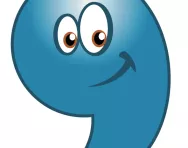
What is a comma?
A comma is a punctuation mark that separates items in a list and marks the divisions within sentences.
How are commas used?
In the primary curriculum, children are taught that commas are used:
- to separate items in a list
- to indicate parenthesis within a sentence with an embedded clause
- to separate direct speech from a reporting clause
- to avoid ambiguity
- to separate main and subordinate clauses.
Commas have lots more uses, including their use within numbers, but our focus is on the most common uses within the primary curriculum.
Commas are used to separate items in a list. They are also used to separate adjectives that qualify the same noun (long, sharp claws). For example: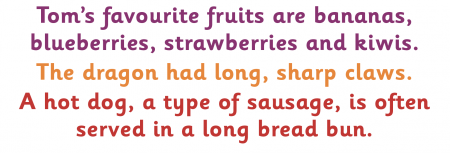
Commas can also be used as an alternative to brackets to show parenthesis or additional information within a sentence as an embedded clause (A hot dog, a type of sausage, is often served in a long bread bun.).
A comma is used to separate a main and subordinate clause, or to separate adverbial phrases from a main clause. For example:
Commas are also used when punctuating direct speech, before quotation marks when the quotation is introduced. For example;![]()
Crucially, commas are used to avoid confusion in writing. For example:
The first sentence suggests that we should eat Grandma, poor lady! The second makes it clear that the writer is telling their grandmother that it is time to eat.
How are commas taught in primary school?
Once they are familiar with the look of commas, and can identify them in the books they are reading, children will be expected to place them accurately in sentences or lists.
This usually occurs first with the use of worksheets, then in structured writing sessions with the aim of producing multiple sentences that require commas.
When it comes to teaching the use of commas to avoid ambiguity, word play and experimentation are often the best way for children to see the importance of the comma within their writing.
When are commas taught in the primary classroom?
In Key Stage 1, most teachers wait until Year 2 to introduce commas for items in a list. This is because using commas to separate adjectives describing the same noun is also taught in Year 2 and teachers feel it is more beneficial to the children to teach these skills at the same time as they both involve listing words.
In lower KS2, commas will be introduced to separate fronted adverbials from the main sentences, often in Year 3.
Usually in Year 3, but sometimes Year 4, children will be taught to punctuate direct speech using a comma. (This is when they are first taught to use inverted commas for speech.)
In upper Key Stage 2, using commas for parenthesis is taught, most often in Year 5.
In Year 5 or 6, children are taught to use commas to clarify meaning and avoid ambiguity.
Children will be assessed on their understanding of comma use in both KS1 and KS2. This is an example of a Year 2 Punctuation, Spelling and Grammar paper question: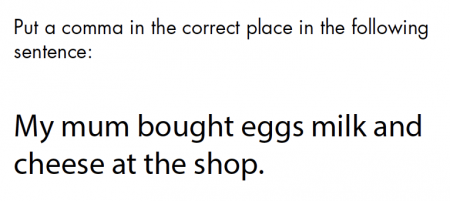
Children will also be required to use commas correctly when they are completing independent writing projects.
